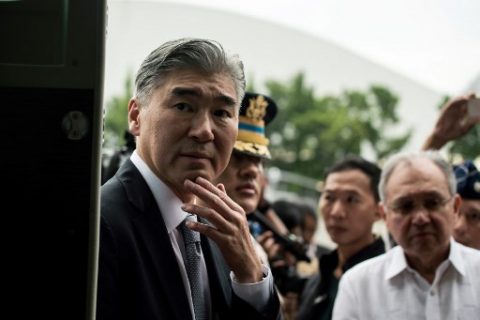
Two Cessna-208B Grand Caravan Intelligence, Surveillance and Recoinnaissance (ISR) aircraft were acquired through the grant programs. The US ambassador said he is working on possible ways to return all three Balangiga bells — taken by US forces in 1901 — back to the Philippines / AFP PHOTO / Noel CELIS
(Eagle News) – Malacanang said it welcomed an earlier pronouncement made by United States ambassador to the Philippines Sung Kim who assured the Philippine government that the US is “trying to reach an early resolution on the Balangiga bells.”
“The Balangiga bells, as the President mentioned, are an important part of our national heritage,” said Presidential Spokesperson Ernesto Abella in a statement.
“The Philippine government will continue to work with the US to pave the way for the rightful return of the Balangiga Bells to the country. The government is also committed to continue to lay the path towards the restoration of our dignity as a nation,” he added.
Last week, the US ambassador said that he would work on possible ways so that all three Balangiga bells — taken by US soldiers after the Balangiga massacre in Samar island in 1901 – will be returned to the Philippines.
“What I can tell you is that we would like to reach a resolution on all three bells. We know that it’s a matter of great importance to the Filipino people and if at all possible we would like to return all three bells to the Philippines as soon as possible,” Kim told reporters on the sidelines of an official turn-over of two Cessna-208B Carawan ISR aircraft donated by the US to the Philippines.
“We know that these bells are very important to the Philippines, to the Filipino people and we in fact have been working for some time to try to reach a resolution on this issue and we’ll continue that effort,” Kim said.
Part of Philippine national heritage
President Rodrigo Duterte, during his second State of the Nation Address, demanded that the US government return the Balangiga bells taken after the infamous Balangiga massacre in 1901, where about 50,000 Filipinos — based on estimates made by historians – had been killed.
“Give us back those Balangiga bells. They are ours. They belong to the Philippines. They are part of our national heritage.”
“Isauli naman ninyo. Masakit yun sa amin,” he stressed during his two-hour Sona on July 24.
One of those in the audience then was the US ambassador who was born in South Korea where one of the Balangiga bells are located, particularly at the 9th Infantry Regiment at Camp Red Cloud in their base in that country.
The two other bells are on a former base of the 11th Infantry Regiment at F.E. Warren Air Force Base in Cheyenne, Wyoming.
Ambassador Kim said that they would want to work with local officials in Wyoming, so the bells could be finally returned to the country.
“So we just want to work with the local officials involved in Wyoming, with our military and other stakeholders to reach a solution that is satisfactory to all parties, but there is no question that we want to reach a resolution,” Kim said.
The three church bells were taken by the American forces after killing Filipinos aged 10 and above in the island province of Samar in reprisal for the surprise attack made by Filipino freedom fighters from Balangiga against Company C of the 9th U.S. Infantry Regiment on September 28, 1901.
There had been previous efforts, both on the part of the Philippines and the US, to return the Balangiga bells, but these had not been successful so far.







